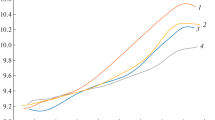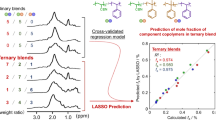Abstract
Copolymers consisting of two or more monomer units are characterized not only by their gross composition, but also by the frequencies of occurrence of their different chemical and configurational sequences. The corresponding chemical micro structure may in principle always be pre-calculated from the kinetics of copolymerization. This calculation has been carried out for radial initiated copolymers of methyl methacrylate (MMA) and methylene malonic acid dimethylester (MME). Independently, the chemical micro structure has been determined by high resolution proton magnetic resonance at 220 MHz. In addition, the configurational micro structure has been elucidated by this means.
In a series of copolymers the fraction of the monomer units has been determined from the spectra, and the copolymerization reactivity ratios r A =0.43±0.02 and r B =0.35±0.05 have been calculated therefrom. The resonance region of the α-CH3 protons has been found to be split into 6 individual peaks which are overlapped to a different degree. The splitting is caused by different chemical and configurational structures in triads of consecutive monomer units. The assignment of the 6 individual peaks to the 6 possible triads, which latter are distinguishable by NMR, has been carried out. The copolymerization model on which the calculation of the reactivity ratios and the elucidation of the assignment has been based, as well as the tacticity parameter σ AA which was also necessary for securing the assignment and which was derived from the NMR spectra of polymethyl methacrylate, have been checked for their validity by means of the areas of the α-CH3 resonance peaks. The conditional probabilities of micro structure as derived from the reactivity ratios and also, independently, from the areas of the α -CH3 peaks have been employed for calculating the frequencies of occurrence for some typical chemical and configurational sequence of monomer units.
Zusammenfassung
Aus zwei oder mehreren Monomerbausteinen aufgebaute Copolymere sind nicht nur durch ihre Bruttozusammensetzung, sondern auch durch die Häufigkeiten der in ihnen enthaltenen — chemisch und konfigurativ unterschiedlichen — Sequenzen charakterisiert. Die entsprechende chemische Mikrostruktur läßt sich grundsätzlich aus der Kinetik der Copolymerisation vorausberechnen, was am Beispiel der radikalisch initiierten Copolymeren aus Methylmethacrylat (MMA) und Methylenmalonsäuredimethylester (MME) in dieser Arbeit erfolgt. Unabhängig davon wurde die chemische Mikrostruktur durch hochauflösende protonenmagnetische Resonanz bei 220 MHz ermittelt; zusätzlich wurde hierdurch auch die konfigurative Mikrostruktur der Copolymeren aufgeklärt.
Der Anteil der beiden Monomerbausteine wurde in einer Reihe von Copolymeren aus den Spektren ermittelt und daraus die Copolymerisationsreaktivitätsverhältnisse zu r A =0,43±0,02 und r B =0,35±0,05 berechnet. Der Resonanzbereich der α-CH3-Protonen wurde als in 6 Peaks aufgespalten gefunden, verursacht durch den unterschiedlichen chemischen und konfigurativen Aufbau von Triaden aufeinanderfolgender Monomerbausteine. Die Zuordnung der 6 Peaks zu den 6 möglichen durch KMR unterscheidbaren Triaden wurde durchgeführt. Das für die Berechnung der Reaktivitätsverhältnisse und die Ermittlung der Zuordnung vorausgesetzte Copolymerisationsmodell sowie der für die Zuordnung ebenfalls benötigte und aus den KMR-Spektren von Polymethylmethacrylat abgeleitete Taktizitätsparameter σ AA , wurden mit Hilfe der Flächen der α-CH3-Peaks auf ihre Gültigkeit hin überprüft. Die bedingten Wahrscheinlichkeiten der Mikrostruktur wurden sowohl aus den Reaktivitätsverhältnissen als auch unabhängig davon aus den relativen Mächen der α-CH3-Resonanzpeaks ermittelt und verwendet, um die Häufigkeiten von Sequenzen chemischer und konfigurativer Art an einigen typischen Beispielen zu berechnen.
Similar content being viewed by others
Literatur
Alfrey, T., Bohrer, J. J., Mark, H. F.: Copolymerization, p. 134. New York: Intersci. Publ. 1952.
Bovey, F. A.: J. Polymer Sci. 62, 197 (1962).
—, Tiers, G. V. D.: J. Polymer Sci. 44, 173 (1960).
— —: Fortschr. Hochpolymer-Forsch. 3, 139 (1963).
Coleman, B. D.: J. Polymer Sci. 31, 155 (1958).
—, Fox, T. G.: J. Polymer Sci. A 1, 3183 (1963).
Enomoto, S., Satoh, S.: Kolloid-Z. 219, 12 (1967).
Fischer, T., Kinsinger, J. B., Wilson III, C. W.: J. Polymer Sci. B 4, 379 (1966).
Frisch, H. L., Mallows, C. L., Heatley, F., Bovey, F. A.: Macromolecules 1, 533 (1968).
Harwood, H. J., Ritchey, W. M.: J. Polymer Sci. B 2, 601 (1964).
— —: J. Polymer Sci. B 3, 419 (1965).
Hatada, K., Ota, K., Yuki, H.: J. Polymer Sci. B 5, 225 (1967).
Hellwege, K. H., Johnsen, U., Kolbe, K.: Kolloid-Z. 214, 45 (1966).
Hopff, H., Lüssi, H., Allisson, S.: Makromol. Chem. 44, 95 (1961).
Ito, K., Iwase, S., Umehara, K., Yamashita, Y.: J. Macromol. Sci. A 1, 891 (1967).
— —, Yamashita, Y.: Makromol. Chem. 110, 233 (1967).
—, Yamashita, Y.: J. Polymer Sci. A 3, 2165 (1965).
— —: J. Polymer Sci. B 3, 625 (1965).
— —: J. Polymer Sci. B 3, 631 (1965).
Johnsen, U.: Z. Elektrochem. 70, 320 (1966).
—, Kolbe, K.: Kolloid-Z. 216, 97 (1967).
— —: Kolloid-Z. 220, 145 (1967).
Kinsinger, J. B., Fischer, T., Wilson III, C. W.: J. Polymer Sci. B 5, 285 (1967).
Klesper, E.: J. Polymer Sci. B 6, 313 (1968).
—: J. Polymer Sci. B 6, 663 (1968).
—, Gronski, W.: J. Polymer Sci. B 7, 661 (1969).
— —: J. Polymer Sci. B 7, 727 (1969).
Küchler, L.: Polymerisationskinetik, S. 203. Berlin-Göttingen-Heidelberg: Springer 1951.
McClanahan, J. L., Previtera, S. A.: J. Polymer Sci. A 3, 3919 (1965).
Mayo, F. R., Lewis, F. M.: J. Am. Chem. Soc. 66, 1594 (1944).
Meerwein, H., Schürmann, W.: Ann. Chem. 398, 214 (1913).
Ramey, K. C.: J. Polymer Sci. B 5, 859 (1967).
Reinmöller, M., Fox, T. G.: ACS Polymer Preprints, Div. Polymer Chem. 7, 987 (1966).
Schäfer, J.: J. Phys. Chem. 70, 1975 (1966).
Tosi, C.: Fortschr. Hochpolymer-Forsch. 5, 451 (1968).
Author information
Authors and Affiliations
Additional information
Vortrag anläßlich der Tagung der GDCh-Fachgruppe „Analytische Chemie“ vom 9.–11. April 1969 in Freiburg i. Br.
Rights and permissions
About this article
Cite this article
Jabben, M., Chafik, A., Saupe, A. et al. Strukturuntersuchungen an Copolymeren aus Methylmethacrylat und Methylenmalonsäuredimethylester durch kernmagnetische Resonanz. Z. Anal. Chem. 249, 1–16 (1970). https://doi.org/10.1007/BF00427237
Received:
Issue Date:
DOI: https://doi.org/10.1007/BF00427237




